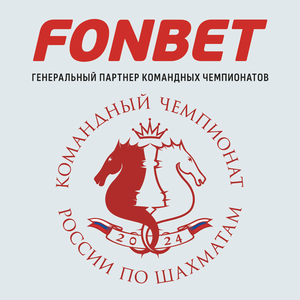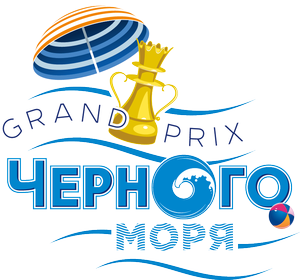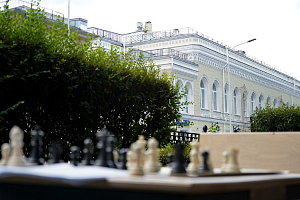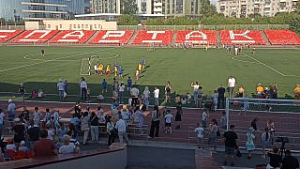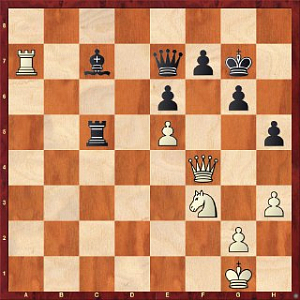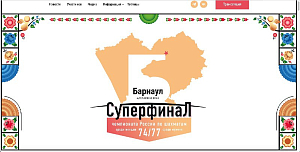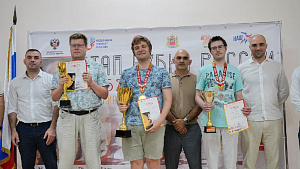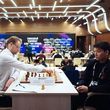Generation 80 Triumphs
Cycle Two of the Russian Cup in Khanty-Mansiysk. Report by Dmitry Kryakvin
Here, in the capital of Yugra, things are running well on track. Uncle Vanya, a driver already known to every Russian chess player, shuttles to/from the tournament playhall, and the cooking staff of the Yugra Academy treats participants to all kinds of overseas dishes and sweets, as well as tea and coffee. The only other-than-usual thing was a visit from the police dog and the policemen. This is, perhaps, how things are supposed to be.
Meanwhile, the St. Petersburg’s Super Final has its tone set by a younger generation, led by Vladimir Fedoseev and Daniil Dubov. As opposed to that, the event running at the same 60th parallel in Western Siberia has seen the majority of young talents leaving the tournament, Dima Gordievsky being the only exception. The surviving gladiators and amazons have gained their experience through multiple different types of tournaments. Here they are: Dmitry Jakovenko, Dmitry Kokarev, Evgeny Shaposhnikov, Baira Kovanova and Elena Tomilova represent the generation 80. It's not for nothing that Boris Gelfand and Levon Aronian reminded us that it's always untimely for a knockout soldier to be nostalgic about his past university years. What if your youth years were such that an immersion water heater was something of a happiness ... Having passed through this, who will you be afraid of then?
The women's section has been a fight to the last bullet, as usual. Baira Kovanova’s victory as Black over Sandugach Shaydullina was pinned to a hope of an easy draw as White, but it was not to be!
Kovanova – Shaydullina
Game two
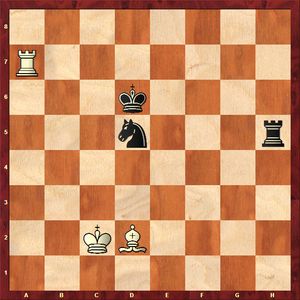
Here Baira probably breathed a sigh of relief, but it was too early to rejoice yet! The grandmaster from the Moscow region kept squeezing a victory for as long as 40 moves yet, and at some point ... Shaydullina managed to change the position’s evaluation from 0.00 to -0.15. It was not enough for anything substantial, though.
The second semi-final did without any such marathons, and a decisive game was that in which the white pieces were in charge of Elena Tomilova.
Tomilova – Belenkaya
Game two
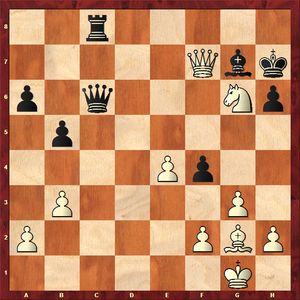
White has come up with a nice sacrifice of exchange, but winning the game takes 32.Qf5. A seemingly logical bishop hookup into the game gave Dina Belenkaya an unexpected chance to make things unclear.
32.Bh3? Rc7?
Black returns the favor. Meanwhile, after 32...Qf6! 33.Qxf6 Rc1+ 34.Kg2 Bxf6 35.Nxf4 Ra1 the fate of the game is not clear as Black grabs the queenside pawn, whereas the connected white passers are far from the queening square.
33.Ne7! Qc1+ 34.Bf1
The checkmating threats force Black to return the exchange, and after 34…Rxe7 35.Qxe7 White converted three extra pawns and a safer king. By the way, it was not yet late to blunder with 34. Kg2 f3+ 35.Kхf3 Qh1+ 36.Kf4 Qc1+, and Dina confirmed seeing a draw via perpetual in this position.
The men’s section witnessed the rampage by Evgeny Shaposhnikov. Being one of the leading national junior players and a participant of the epic China-Russia match to give a lot of headaches to the current national players of the Celestial Empire, he dug out his hatchet. Woe to those who find themselves standing in his way!
Golubov – Shaposhnikov
Game two
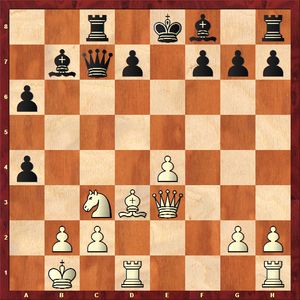
Saveliy needed to come back in the match, and instead of 18.Nxa4 he resorted to an overly ambitious
18.Nd5? Qe5 19.Qb6
It was met by a crushing 19…Bc5!, and the b7-bishop is immune in view of 20.Qxb7 Rb8 21.Nc7+ Ke7 22.Nd5+ Kf8. Saveliy retreated his queen, but fell prey to a sweeping attack anyway. 20.Qa5 a3 21.c3 0–0 22.Rhf1 Bxd5 23.exd5 axb2, and the Saratov grandmaster found himself in the final shortly after.
Now Evgeny Shaposhnikov is to face the home player Dmitry Jakovenko. I have come to notice that cycle two, more often than not, comes heavily on the three-time Cup holder; as has been the case this time as well. Game one had Jakovenko on the brink of defeat at some point, and the grandmaster admitted to your correspondent that had David discovered the strongest continuation, it would have been only a miracle to hope on. In game two, though, Paravyan mishandled the opening, but fought hard not to go down...
Paravyan – Jakovenko
Game two
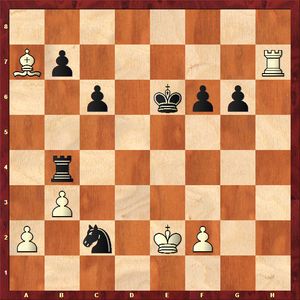
This was the moment of the game when Dmitry had practically reconciled to the thought of having let all his edge go. Nevertheless, it did not prevent him from coming up with an idea that finally paid off.
35... Rb5 36.Kd2 Nb4 37.a4 Rd5+ 38.Kc3 Na2+!? 39.Kc2
There is no way forward as it results in a checkmate: 39.Kc4 b5+ 40.axb5 cxb5#. It was not yet late to retreat, and how to go about the b7-pawn was yet to be demonstrated.
39...b5
Taking into account the limited number of pawn material, 40.Be3 is a good continuation, as well as a more concrete approach 40.a5 c5 41.Rb7 Nb4+ 42.Kc1. Much to his grief, Paravyan decided in favor or yet another option.
40.Rc7 Kd6 41.Bb8? Nb4+! 42.Kc3 Na6
The agile knight is back, and the rook ending is an utterly uphill battle for White as the f2 pawn is hanging, which requires posting the rook passively to address this problem
43.Rb7+ Nxb8 44.Rxb8 Rf5

45.Rd8+
45.a5 Rxf2 46.b4 g5 should not be of help either.
45...Kc7 46.Rd2 Kb6 47.axb5 Kxb5 48.Kb2 c5
Black’s plan is simple - he pushes the pawns as far as possible while combining threats against b3 and f2. It is instructive that Jakovenko repeated moves twice (to be on the safe side, to gain time?) along with classical players’ testaments. But what am I talking about? Dmitry is one of those modern classical endgame connoisseurs.
49.Re2 g5 50.Rc2 Rf3 51.Ka2 Kb4 52.Rc4+ Kb5 53.Rc2 f5 54.Kb2 Kb4 55.Rc4+ Kb5 56.Rc2 g4 57.Ka2 Kb4 58.Rc4+ Kb5 59.Rc2 Rh3 60.Ka3 Rh2, with no longer any defending against f5-f4, g4-g3.
Excellent knowledge of textbook novelties was demonstrated by Dmitry Gordievsky. A participant of the 2018 Wijk aan Zee reserve tournament scored the first victory against Semen Lomasov and braced himself for the return game as Black. Lomasov is a very creative young man with many ideas under his belt, and eventually Gordievsky stopped his choice on the Alekhine defense. He did so upon having previously studied lines from the book by Evgeny and Vladimir Sveshnikovs "A Chess Opening Repertoire for Blitz & Rapid".
Nevertheless, it was not as easy as written in the book. While Evgeny Ellinovich and his son’s recipe for the so-called Voronezh line did hit home this time, Dima had been most apprehensive of the four pawns system. It should be added, though, that the lines analyzed in the monograph are suitable for blitz only, while in reality White has an analytically winning position. This said, Semen handled the opening meticulously, attempting to put some oil into the flame only when faced with an unfamiliar setup.
Lomasov – Gordievsky
Round 2
1.e4 Nf6
The Alekhine Defence is based on a sound positional foundation. Another thing is that Bagirov’s days are over, and the main knight pirouettes bearing the name of San Sanych (Alekhine) have been worked out in detail by now. It is a different story if White is not versed in the opening theory... I remember well Alexander Grischuk not equalizing here and scraping a draw against Daniil Yuffa.
2.e5 Nd5 3.d4 d6 4.c4 Nb6 5.exd6 exd6 6.Nc3 Be7 7.Bd3 0–0 8.Nge2 Na6
This is the very idea of Sveshnikovs - let Tarrasch forgive us all. Anyone would be surprised in Lomasov’s shoes as well - the knights jump back and forth, and then it turns out that Black’s position is gorgeous from the statical point of view.
9.b3 c6 10.0–0 Nb4 11.Bb1 d5 12.c5 Nd7 13.Ng3
This is perhaps not the best square for the knight; the move needs further analysis anyway.
13…g6 14.Bh6 Re8 15.a3 Na6 16.Ra2 Bf8 17.Qd2 Bxh6 18.Qxh6 Nf8 19.Nce2 f5 20.Nf4 Qf6
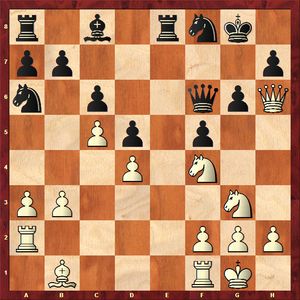
Here Semen Lomasov decided it was time to burn the house, but in the line
21.Ngh5? Qxd4 22.Qg5 Kf7 23.Rd2 Black shined with a Carlsen- and Tsydypov-like – 23…Qh8!, which leaves White’s piece and pawn en prize. There followed 24.Ng3 Nxc5, and a dozen moves later the semifinal received its last remaining representative of the younger generation (however, it could not be otherwise).
Meanwhile, in the Alekseenko-Kokarev battle a three-time winner of the Chigorin Memorial could not stop the finalist of the latest two years’ Cups. Although the classical chess was dictated by Kokarev, he failed to convert game two. However, when it came to tie-breaks, a goal-scoring opportunity presented itself to his opponent.
Kokarev – Alekseenko
Rapid game one
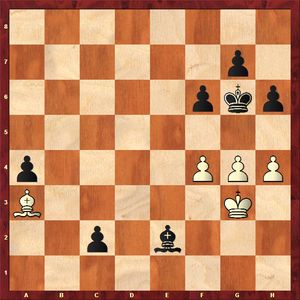
Black is up two pawns, and White is after building a fortress. Soon his aspirations came true.
59… f5? 60.g5 Kf7 61.Kf2 Bc4 62.Ke3 Kg6 63.Kf3 Kh5 64.Kg3, and the white king is alway in time to oppose his black counterpart: 64…Bd5 65.Bb2 Be4 66.Ba3 Kg6 67.Kf2 Bc6 68.Bb2 Bb7 69.Ba3 Be4 70.Bb2 Kf7 71.Ke3 Ke6 72.Kd2 Draw.
When watching the game with Jakovenko, Dmitry immediately exclaimed: “The f5-square is needed for the Black king to infiltrate White’s position, easily winning was 59...h5!” Indeed, White is not helped by 60.f5+ Kf7 61.gxh5 Bxh5 62.Kf4 Ke8 63.Ke3 Bg4 64.Ke4 Kd7 65.Kf4 Bh3 66.Ke4 Kc6 with a decisive breakthrough . “Such opportunities are not to be missed - fate will not let it go like that!” was summed up by the rating favorite. The prophesy came true when Dmitry Kokarev loomed large in Armageddon. He was severe, adamant, with moves as solid as if screwing pieces into the board. A while ago neither Sjugirov nor Fedoseev managed to match him ... Now it has been Alekseenko's turn.
In the second semifinal Dmitry Kokarev will challenge yet another younger generation representative. Here in Khanty-Mansiysk they run their own sort of "Nutcracker” knockout. Meanwhile, the young princes fail to tame the uncrowned king from Penza. It is Gordievsky’s turn to ascend the stage to try his hand in doing so.
Photos by Dmitry Kryakvin








